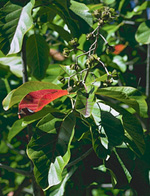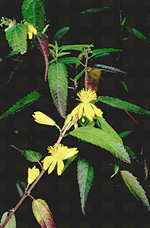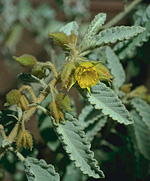 |
Primarily tropical and subtropical, Tiliaceae is represented in Australia by a few genera found in rainforests, vine scrubs and woodlands across northern Australia from the Kimberley region of Western Australia to northern New South Wales.
Characteristic features of the family Tiliaceae in Australia include:
- trees or shrubs with alternate, simple, usually finely toothed leaves,
and normally with stellate hairs on leaves and stems and hair tufts
(domatia) in the angles of the lateral veins beneath
- flowers small, yellow or white, usually borne in axillary panicles
or cymes, with 4 or 5 free sepals and petals, the latter often glandular-hairy
at the base
- stamens mostly 5–10, rarely more or less, irregularly arranged
and often more prominent than the petals
- fruit a rather dry, often hard drupe, sometimes bristly, or a capsule
Description
Evergreen or deciduous trees, or shrubs, or annual or perennial terrestrial herbs, or rarely woody scrambling vines. Perennating by taproots or crowns. Stem internodes solid, or spongy, or pithy. Internal secretions not obvious. Plants with simple or stellate, glandular or non-glandular, unicellular, uniseriate or multiseriate hairs, or peltate scales. Leaves alternate and spiral, or distichous, cauline if herbs, petiolate. Stipules distinct and free from the petiole, scale-like or membranous, falling off early. Lamina simple, symmetric or rarely asymmetric, lanceolate, ovate, elliptic, oblanceolate, obovate or orbicular; base cuneate, cordate, or rarely attentuate or oblique; margins entire, crenate, dentate or serrate, ±flat; one-veined, with the midrib conspicuous, and the tertiary venation reticulate; surfaces not punctate; herbaceous or leathery. Domatia consisting of hair tufts in the vein angles. Usually with all the flowers bisexual, or with male and female flowers occurring on separate plants. Inflorescences terminal, axillary or leaf opposed, consisting mostly of panicles or cymes, or rarely solitary flowers. Bracts present. Pollination by insects. Flowers odourless or fragrant, stalked. Floral disc present or absent; nectaries present on the perianth, carpels or stamens. Perianth regular, of 2 dissimilar whorls or rarely of 1 whorl only. Epicalyx rarely present. Calyx segments free or rarely fused, with 4–5 sepals or lobes, valvate in bud; calyx cup-shaped, herbaceous. Corolla segments free, with 4–5 petals, alternating with the sepals or calyx lobes, imbricate or valvate in bud, white, yellow or orange, or rarely violet, without contrasting markings, membranous; claws present or absent; lobes ±entire. Fertile stamens (3–) 5–10 (–numerous), alternating with the sepals or calyx lobes, free of the corolla, free of the ovary and style, distinct from each other or grouped or fused into bundles, rarely fused by their filaments into an open or closed tube, all ±equal. Staminodes rarely present. Anthers dorsifixed or rarely basifixed, not versatile, opening inwards by longitudinal slits, 2-celled. Ovary superior and sessile. Carpels 2–5, fused, or rarely free but styles or stigmas fused; ovary with 2–10 locules. Style terminal, single and unbranched and the stigma capitate, fimbriate or in style cleft. Ovules 2–numerous, stalked or sessile; placentation axile or rarely parietal. Fruit a dry dehiscent septicidal or loculicidal capsule, or a fleshy, indehiscent berry, or a drupe; the perianth on the maturing fruit deciduous, rarely dry and persistent or growing larger. Disseminule macro-surface featureless or with straight or hooked hairs; micro-surface ±smooth, brown or black, dull. Seeds 1–numerous per fruit. Aril absent. Cotyledons 2. Embryo straight.
(Note: this description has been generated from the coded data compiled for the key. Any errors in the key data will be reflected in the descriptions.)
A treatment of the family Tiliaceae has not yet been published in the Flora of Australia. It will appear in Volume 7.
Australian genera of Tiliaceae (as recognised for the Flora of Australia)
† = some species native, others introduced
Althoffia
Berrya
Brownlowia
†Corchorus
Grewia
Schoutenia
Triumfetta

|
  |

Berrya javanica (fruits)
Photo: H.Nicholson © H. & N. Nicholson

Corchorus cunninghamii (flowers)
Photo: M.Fagg © ANBG

Corchorus sidoides (flowers)
Photo: M.Fagg © ANBG

Corchorus walcottii (flowers)
Photo: D.Greig © ANBG

|
 |
|